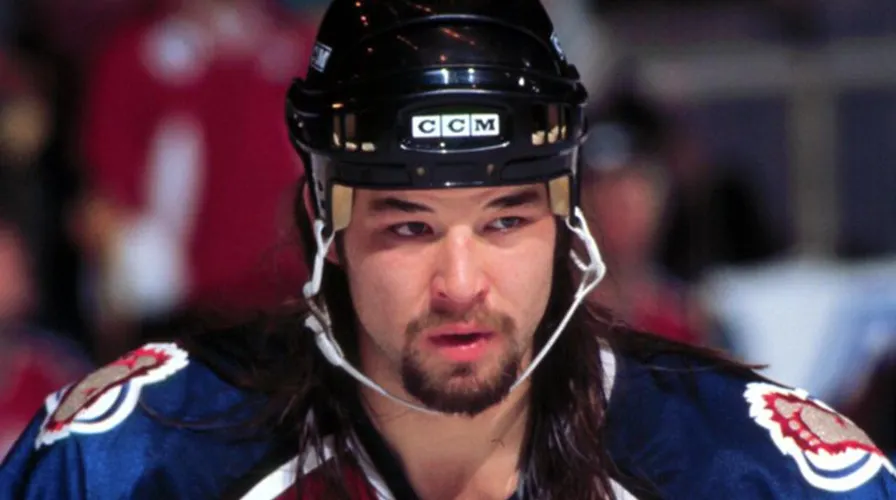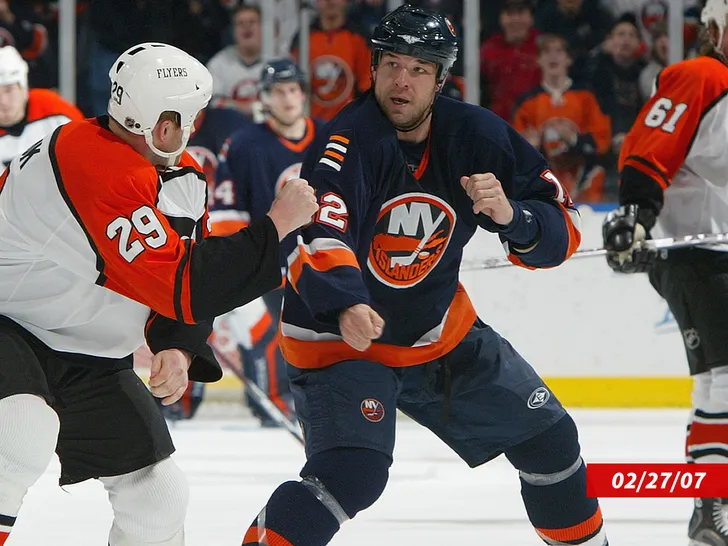
The hockey enforcer, formerly known as the Goon, is an endangered species in professional hockey. In many regards, that’s probably for the best, all around. But…it’s complicated. (And this is coming from a fan who for many years took hockey very seriously, and at the same time genuinely loathes violence.)
I’ve written more than a little about hockey fighting (and fighting in general, especially as it’s portrayed in media), but there are at least two undeniable, and distressing, elements at play as it relates to our appetite for violence and they both involve the spectacle of it.
One the one hand:
When we think about the distinctive ingredients of Americana, the elements that comprise what we think about when we think of what makes America so…American, it’s easy to recite the clichéd short-list: mom, apple pie, convertibles, rock and roll, McDonalds, sexual repression, colonialism, enhanced interrogations, et cetera.
But really, when you get down to it, we are all about violence. And, to a large degree, violence sort of encompasses all of the things listed above (the violence we do to others, the violence we do to the environment, the violence we do to ourselves–inherent in the desires we succumb to as well as deny, which are epitomized by most religions). But our religion is violence, and our cathedral has long been the silver screen. So we celebrate our addiction to violence in ways less brutal but more calculated than the barbaric Gladiator spectacles of yesteryear (we weren’t Americans yet): by perfecting what has become a universal aesthetic, the movie fight scene. Kind of like porn movie plots are a delivery device for the fucking, action movie plots are often a disposable fulcrum for the fighting.

On the other hand:
Think about what a clown does: he is the minor but essential character who shows up at a circus with the objective of instigating misconduct. Above all, his purpose is to entertain with a mixture of mischief and cheer. A superficial assessment might conclude that a clown is simply doing, in make-up, what any drunk idiot might do. But of course whether it is juggling, dancing or doing tricks, not just anyone could be (or would want to be) a clown. It’s a job.
Think about what a hockey enforcer (what we used to call a goon just like we used to call escorts hookers or stockbrokers sociopaths) does: he is the minor but essential figure who shows up in an arena with the object of instigating misconduct (hopefully without receiving a game misconduct). Above all, his purpose is to settle scores and entertain a crowd while invigorating his teammates. A superficial assessment might conclude that an enforcer is simply doing, in a colorful costume, what any drunk idiot might do. But needless to say, trading bare-fisted blows (sober or especially drunk) in a bar is considerably different than standing on skates and going toe to toe with an opponent who is well-prepared (and in some cases, well-paid) to kick your ass in front of thousands of people. Many people without athletic ability are very capable goons; only an extremely select group of individuals are able (much less willing) to abide by “The Code”. It’s a job.
It’s difficult to talk intelligently with anyone about hockey because so few people watch (or care) about it. That goes double when trying to articulate the science of sanctioned pugilism. How can one possibly rationalize or defend the spectacle of adults engaging in behavior that would get them arrested out in the streets? (Indeed, fans are arrested nightly at hockey rinks all over the continent for imitating, albeit often drunkenly and with far less flair, the very behavior occurring in real time below them.) The answer is at once easy and complicated, like all truths tend to be. The easy part: there is no need to explain it. If you’re not a hockey player, you can’t hope to comprehend it; unless you are a fan, you have no hope of understanding or appreciating it. It’s really that simple. Seriously. Just ask a hockey player. (And, as perspicacious commentators have pointed out for decades, one notices how nobody gets up to grab popcorn once a fight breaks out. While that may speak volumes about the distressing devolution of our species and our insatiable appetite for violence, there is something a bit more sophisticated going on.)
Check it out:
Then consider this, the moment that launched, in no particular order, Chris Simon’s reputation as the heavyweight NHL champ, the moment the GOAT (Bob Probert — and much more about him here) was dethroned, and –according to fans and teammates– what catapulted the Colorado Avalanche toward their first championship. It’s easy to dismiss the type of brawl that would immediately get any other civilian arrested, but as I say, it’s…complicated.
Simon came to the nation’s capital the year after establishing himself as the Alpha Male, and he was a mainstay with the Washington Caps for many seasons. Speaking as a big fan (always remember, fan derives from fanatic), Simon was a joy to watch and he was a favorite son of this city not only for his fists, but his overall play and, by all accounts, good nature. There was, however, a backstory, and toward the end of his career, as his skills (on skates and in brawls) diminished, I worried that a host of demons would make post-hockey life at best challenging.
The actual history of his difficulties is sufficiently documented (shout out to Ted Nolan), and folks interested in more can easily find out with the click of a mouse. I also acknowledge that his livelihood may have done as much to exacerbate his issues as it did to ameliorate them. In other words, he quite possibly may have gone down certain roads whether or not he played hockey or threw a single punch. But I readily concede that there is an ugly side to sports, just like there is a sinister side to life, and all of us are constantly pushed and pulled by the momentum of necessity and choice, and the inexorable reality that we have to pay bills and obey laws. A more sustained –and serious– discussion of sports, hockey, hockey fighting and some of the casualties of this game (in general) and CTE (in particular) is ongoing. Tragedies like Simon (and Probert, and many other enforcers before and after him) will hopefully inspire a more honest and useful response from the people making lots of money off these gladiators.
My heart is heavy. Rest well, Chief.
